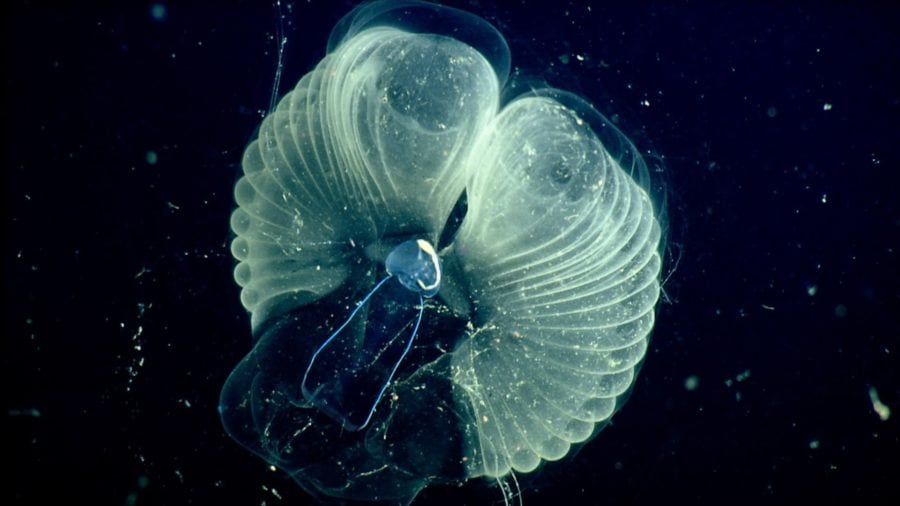The giant larvacean is a floating croissant housed in mucous

Bec Crew
Bec Crew

A FRAGILE, FREE-floating organism found throughout the world’s oceans, the giant larvacean is a tunicate – a type of invertebrate known for its protective, tunic-like exoskeleton made of proteins and carbohydrates.
Only the giant larvacean doesn’t have a tunic. Instead, it secretes enough mucous to construct a balloon-like ‘house’ that encloses the animal and captures morsels of food from the water.
This clever snot house is made up of two filters. The outer filter, which looks like a giant cloud floating around the larvacean, traps all manner of dead or drifting plants and animal particles. It pushes the smaller particles into the inner filter (the croissant-looking structure), while keeping the larger ones out of the way.
The inner filter funnels the small particles down into the giant larvacean’s mouth.
Like an old kitchen sponge, eventually the mucous house becomes so full of debris, the giant larvacean will ditch it and create a new one. Of course, these old houses make for an absolute feast for other sea creatures once it hits the ocean floor.
Giant larvaceans are named for their huge houses, which can grow up to a metre wide. The tadpole-like creature inside will barely stretch to 10 cm long, including its tail.
You can see here how the giant larvacean flaps its tail inside its mucous house to move through the water:
That’s the first ever 3D reconstruction of the giant larvacean, released just last month by scientists from the Monterey Bay Aquarium Research Institute (MBARI) in California.
You can read about how they did it here.
The giant larvacean belongs to the genus Bathochordaeus, and is split into three species.
One, Bathochordaeus charon, is so rare, it disappeared for more than 100 years after being discovered in 1900. In 2016, scientists from MBARI found one using a remotely operated vehicle.
Here’s footage of another species, Bathochordaeus mcnutti, discovered by MBARI in 2017:
The third species, Bathochordaeus stygius, can be found all along the east coast of Australia. But you’ll likely never encounter a live one – they live in the pelagic zone, which is at least 200 metres deep.
Giant larvaceans aren’t just fascinating creatures – they’re also incredibly useful.
According to a 2017 study, of all the planktonic organisms (including bacteria, algae, protozoa and drifting or floating animals) they hold the record for transmitting the largest quantities of carbon from the atmosphere into the deep ocean.
They do this through their habit of shedding their old mucous houses. Every 24 hours or so, they’ll drop it like a deflated balloon, and all of tshe carbon-laden flesh, plant fodder, and even microplastics, will fall away with it.
“This helps the ocean remove carbon dioxide from the atmosphere and carries microplastics from the water column down to the seafloor,” Kim Fulton-Bennett reports for MBARI.
Here’s more awesome footage of Bathochordaeus mcnutti:

